
|
 |
Martin M-130 China Clipper |
 |
 |
 |
 |
 |
|---|---|---|---|---|---|---|---|
 |
 |
 |
 |
 |
|||
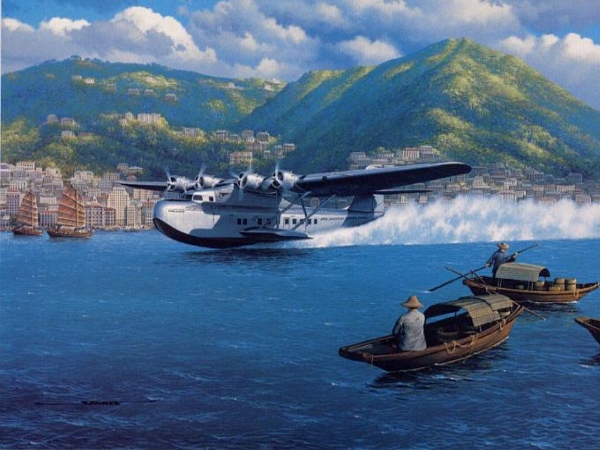 |
||
|
Following the Sikorsky S-42, the huge trans-oceanic Martin Model 130 flying boats, used by Pan American Airways during the 1930s, resulted from the same specification to which Sikorsky had evolved the S-42. However, unlike the S-42, the Martin 'China Clipper,' as it was to become known, truly possessed the long-range over-water capability that the airline required. |
| Pan Am's planned trans-Pacific route to the Philippines was San Francisco, Honolulu, Midway Island, Wake Island, Guam, and Manila. The five legs lengths respectively were: 2,410, 1,260, 1,320, 1,500 and 1,600 miles (3,880, 2,230, 2,125, 2,415 and 2,575 km). Finally Hong was added to the route for an additional 600 miles (965 km). To accomplish this, it required an aircraft with a non-stop range of 2,500 miles (4,025 km) carrying 12 passengers, which even by mid-1930s standards was hardly an economic payload/weight ratio. While the routes were being surveyed in 1935 by the S-42B, Martin was building three M-130's, which were named China Clipper (NC 14716), Philippine Clipper and Hawaii Clipper. |
| The M-130 was of all-metal construction except for the fabric trailing edge. It had a two-step double-bottom hull, with upper sections constructed of corrugated duralumin sheeting. Sponsons, sometimes called 'sea wings', were fitted to the hull sides at cabin floor level. These airfoil-shaped surfaces fulfilled a dual function; they helped to stabilize the airplane while resting or maneuvering on the water and also served as fuel storage for nearly half of the flying boat's 3,800 US gallon (14,383 liter) fuel load. Retractable platforms were built into the leading-edge of each wing on either side of each engine nacelle, to provide access for servicing the engines—two of which were completely changed every three trips. |
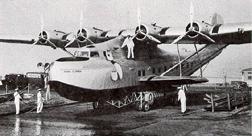 |
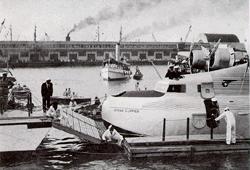 |
|
|---|---|---|
| Retractable platforms were built into the leading-edge of each wing on either side of each engine nacelle, to provide access for servicing the engines. | ||
|
The flight crew of five comprised captain, first officer, radio officer, flight engineer and steward. Aft of the flight deck, in order, were the forward passenger compartment, lounge and two rear passenger compartments. Each passenger compartment could accommodate 8 seats or 6 sleeping berths, and the lounge seated 12. While the M-130 could accomodate up to 32 passengers, the long distance payload was only 12 passengers. Altogether, one can appreciate the declaration by one American observer that passengers 'rattled around in the vast expanse of hull in a degree of comfort never known before'.
A typical passenger would have been very wealthy as well as adventurous. The one-way fare from San Francisco to Manila was $799, roughly $10,000 in today's money—twice the price of a seat on the supersonic Concorde. The fare to Hong Kong was $950 one-way, which was certainly out of the reach for most people except for the very well off.1
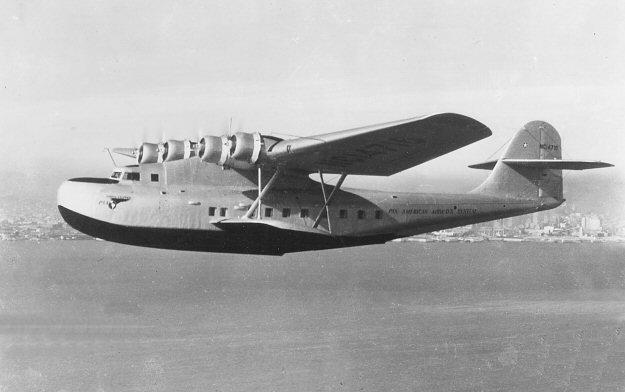
Proving flights were made in late 1935 and early 1936, with the China Clipper making the first ever commercial double crossing of the Pacific between November 22, 1935 and December 6, 1935. The full regular trans-Pacific M-130 service opened on October 21, 1936, the flight spanning five days and occupying a total of 60 hours actual flying. This was a vast improvement over the fastest passenger ships of the day which would have taken 21 days. By 1940, (Hawaii Clipper having disappeared, without a trace, over the Pacific in 1938 with the loss of nine crew and six passengers) the surviving pair of M-130s had accumulated some 10,000 flying hours each, equal to an average daily utilization of 5-1/2 hours and having flown 12,718,200 passenger miles (20,467,930 passenger km) in addition to express and mail flights. The Japanese attack on Pearl Harbor, December 7, 1941, brought the age of Pacific flying boats to an abrupt end. Pan American Airways was still operating regularly scheduled flights at the time of the attack. Wake Island was marked for special Japanese attention, and a devastating air raid blasted its facilities to shreds. The Philippine Clipper was moored at Wake during the attack, and was machine-gunned. It was not destroyed, but peppered with 97 bullets. The M-130 managed to evacuate Pan Am personnel from the stricken island. Unfortunately, nine of Pan Am's complement of 66 employees were killed in the raid. The only Pacific run that Pan Am had left during the war was the vital California-Hawaii run. Pan Am placed itself at the disposal of the US government and did a sterling service throughout the war.
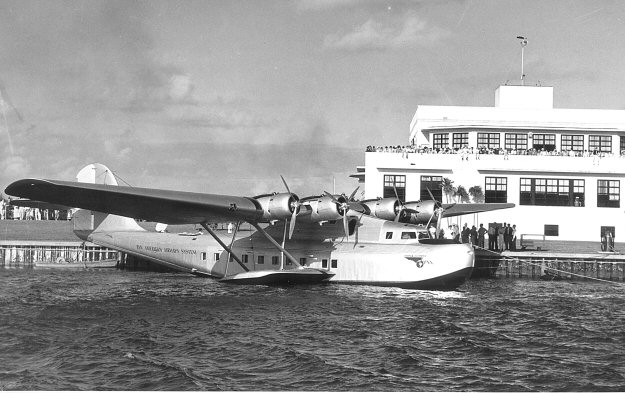
In 1942, the M-130s were impressed for war service as US Navy transports, though not given a Naval designation. The Philippine Clipper crashed in January 1943 when it crashed into the side of a mountain, while landing in San Francisco Bay killing 18 crew and passengers. The China Clipper was wrecked on January 8, 1945, shortly after the tenth anniversary of its first flight, when it struck an unlit boat during a night landing in the Port of Spain, Trinidad, killing 23 crew and passengers. A flying boat larger than the M-130, the Model 156, was built by Martin in 1937. This model, closely followed the design of its predecessor, except for the provision of twin fins and rudders. It was powered by four 1,000 hp Wright Cyclone engines and could accommodate 33-53 passengers (compared with a maximum of 32 in the M-130) and had a gross weight of 63,000 lb (28,576 kg). |
| Specifications: | |
|---|---|
| Martin M-130 "China Clipper" | |
| Dimensions: | |
| Wing span: | 130 ft 0 in (39.70 m) |
| Length: | 90 ft 10.5 in (27.70 m) |
| Height: | 24 ft 7 in (7.50 m) |
| Wing Area: | 1,769 sq ft (164.34 sq m) |
| Weights: | |
| Empty: | - |
| Maximum T/O: | 52,252 lb (23,701 kg) |
| Performance: | |
| Maximum Speed: | 180 mph (290 km/h) |
| Cruising Speed: | 130 mph (209 km/h) |
| Service Ceiling: | 10,000 ft (3,048 m) |
| Range: | 3,200 miles (5,150 km) |
| Powerplant: | |
|
Four 830 hp (618 kW) Pratt & Whitney R-1830 Twin Wasp 14-cylinder, air-cooled, radial engines. |
|
Endnotes:
|
1. Eric Niderost. "Martin M-130 Flying Boat: China Clipper's Trans-Pacific Flights." Aviation History Magazine. March 2000. |
©Larry Dwyer. The Aviation History Online Museum.
All rights reserved.
Created November 20, 2001. Updated November 3, 2013.